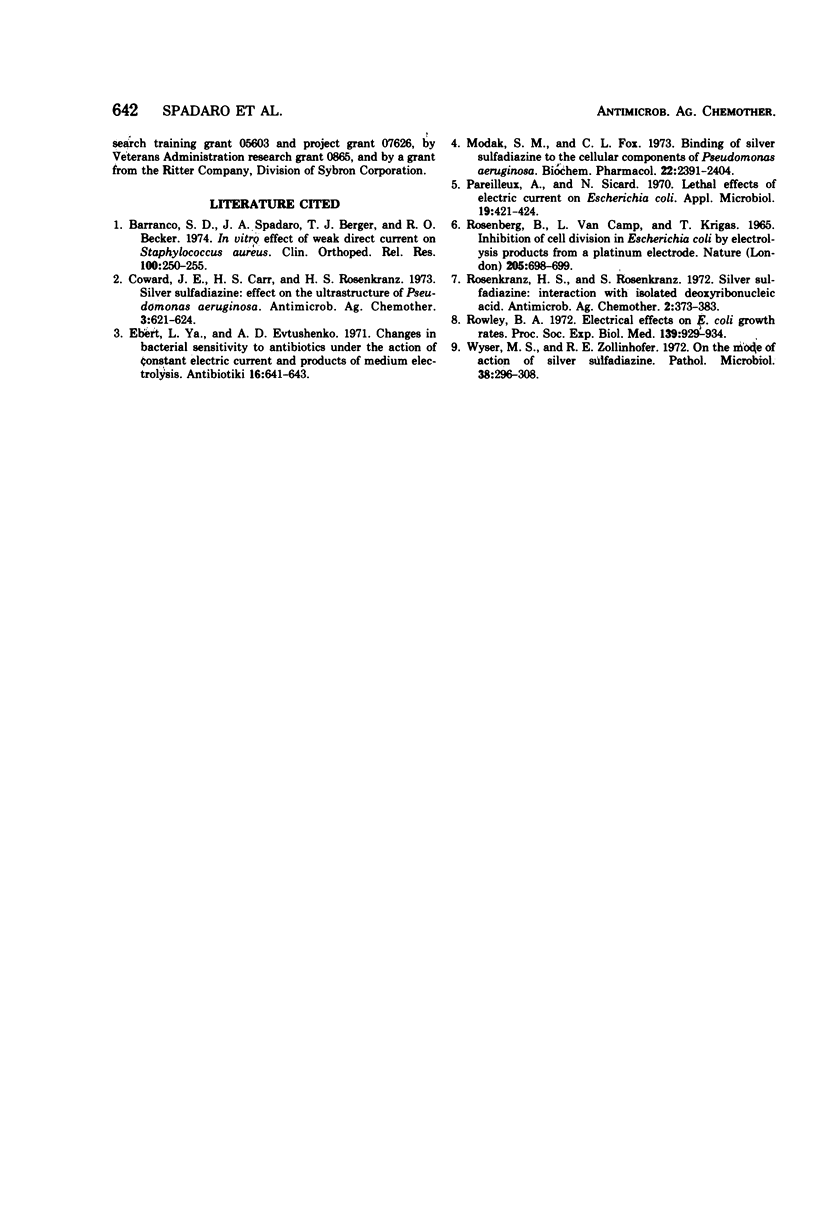Abstract
Silver, platinum, gold, stainless-steel, and copper electrodes were used with low currents (0.02 to 20 μA/mm2) to explore their electrochemical effects on the growth of four bacterial species. In the higher current ranges, all electrodes inhibited growth at both poles, usually in conjunction with electrolytic break-down of the medium and severe corrosion of the metal. Silver, however, was extremely bacteriostatic, even at the lowest current, when used as the anode. Quantitative studies showed that most of this inhibition takes place in a few hours and is not accompanied by changes in pH. Electrochemically injected silver from the anode is probably the instrumental agent, being effective in concentrations of about 5 μg/ml. This is the equivalent concentration of silver sulfadiazine that has been shown to give complete inhibition of bacteria, but without the sulfonamide moiety.
Full text
PDF





Images in this article
Selected References
These references are in PubMed. This may not be the complete list of references from this article.
- Barranco S. D., Spadaro J. A., Berger T. J., Becker R. O. In vitro effect of weak direct current on Staphylococcus aureus. Clin Orthop Relat Res. 1974 May;(100):250–255. [PubMed] [Google Scholar]
- Coward J. E., Carr H. S., Rosenkranz H. S. Silver sulfadiazine: effect on the ultrastructure of Pseudomonas aeruginosa. Antimicrob Agents Chemother. 1973 May;3(5):621–624. doi: 10.1128/aac.3.5.621. [DOI] [PMC free article] [PubMed] [Google Scholar]
- Modak S. M., Fox C. L., Jr Binding of silver sulfadiazine to the cellular components of Pseudomonas aeruginosa. Biochem Pharmacol. 1973 Oct 1;22(19):2391–2404. doi: 10.1016/0006-2952(73)90341-9. [DOI] [PubMed] [Google Scholar]
- Pareilleux A., Sicard N. Lethal effects of electric current on Escherichia coli. Appl Microbiol. 1970 Mar;19(3):421–424. doi: 10.1128/am.19.3.421-424.1970. [DOI] [PMC free article] [PubMed] [Google Scholar]
- ROSENBERG B., VANCAMP L., KRIGAS T. INHIBITION OF CELL DIVISION IN ESCHERICHIA COLI BY ELECTROLYSIS PRODUCTS FROM A PLATINUM ELECTRODE. Nature. 1965 Feb 13;205:698–699. doi: 10.1038/205698a0. [DOI] [PubMed] [Google Scholar]
- Rosenkranz H. S., Rosenkranz S. Silver sulfadiazine: interaction with isolated deoxyribonucleic acid. Antimicrob Agents Chemother. 1972 Nov;2(5):373–383. doi: 10.1128/aac.2.5.373. [DOI] [PMC free article] [PubMed] [Google Scholar]
- Rowley B. A. Electrical current effects on E. coli growth rates. Proc Soc Exp Biol Med. 1972 Mar;139(3):929–934. doi: 10.3181/00379727-139-36269. [DOI] [PubMed] [Google Scholar]
- Wysor M. S., Zollinhofer R. E. On the mode of action of silver sulfadiazine. Pathol Microbiol (Basel) 1972;38(4):296–308. doi: 10.1159/000162423. [DOI] [PubMed] [Google Scholar]




